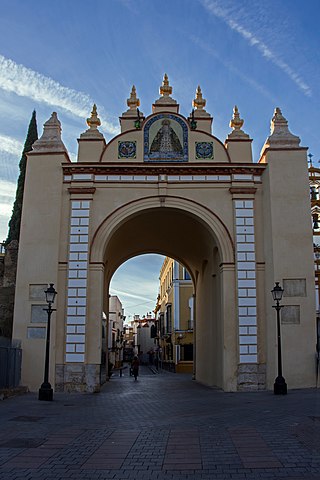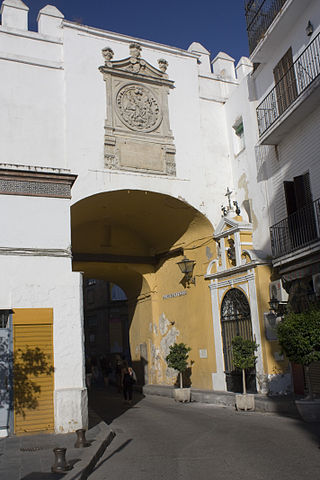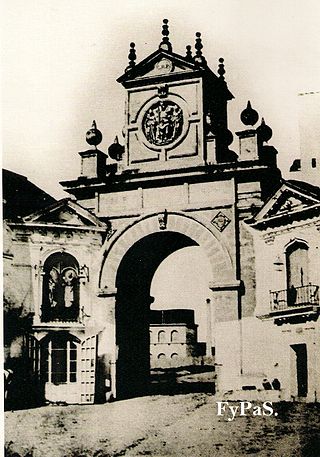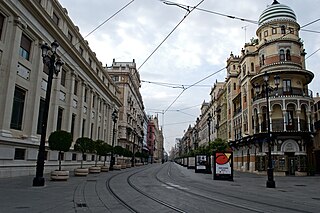
Seville is the capital and largest city of the Spanish autonomous community of Andalusia and the province of Seville. It is situated on the lower reaches of the River Guadalquivir, in the southwest of the Iberian Peninsula.

Carmona is a town of southwestern Spain, in the province of Seville; it lies 33 km north-east of Seville.

The Cathedral of Saint Mary of the See, better known as Seville Cathedral, is a Catholic cathedral and former mosque in Seville, Andalusia, Spain. It was registered in 1987 by UNESCO as a World Heritage Site, along with the adjoining Alcázar palace complex and the General Archive of the Indies. It is one of the largest churches in the world as well as the largest Gothic cathedral.

Juan de Herrera was a Spanish architect, mathematician and geometrician.

The Alcázar of Seville, officially called Royal Alcázar of Seville, is a historic royal palace in Seville, Spain. It was formerly the site of the Islamic-era citadel of the city, begun in the 10th century and then developed into a larger palace complex by the Abbadid dynasty and the Almohads. After the Castilian conquest of the city in 1248, the site was progressively rebuilt and replaced by new palaces and gardens. Among the most important of these is a richly-decorated Mudéjar-style palace built by Pedro I during the 1360s.

Macarena is one of the eleven districts into which the city of Seville, capital of the autonomous community of Andalucía, Spain, is divided for administrative purposes. It is located in the north of the city, bordered to the south by the Casco Antiguo and San Pablo-Santa Justa suburbs, to the east and north by Norte and to the west by Triana. It covers the area between the Guadalquivir River and the Carmona Highway and from the SE-30 ring-road in the north to the Ronda del Casco Antiguo. It contains smaller neighbourhoods such as León XIII, Miraflores, and the Polígono Norte as well as the Miraflores park along the SE-30. The district contains the Andalucian Parliament, the Torre de los Perdigones in the park of the same name, and the Hospital Universitario Virgen Macarena

Triana is a neighbourhood and administrative district on the west bank of the Guadalquivir River in the city of Seville, Spain. Like other neighbourhoods that were historically separated from the main city, it was known as an arrabal. Triana is located on a peninsula between two branches of the Guadalquivir, narrowly linked to the mainland in the north. Two other districts are also usually included in this area, Los Remedios to the south and La Cartuja to the north.

Seville, the capital of the region of Andalusia in Spain, has 11 districts, further divided into 108 neighbourhoods.

The history of Carmona begins at one of the oldest urban sites in Europe, with nearly five thousand years of continuous occupation on a plateau rising above the vega (plain) of the River Corbones in Andalusia, Spain. The city of Carmona lies thirty kilometres from Seville on the highest elevation of the sloping terrain of the Los Alcores escarpment, about 250 metres above sea level. Since the first appearance of complex agricultural societies in the Guadalquivir valley at the beginning of the Neolithic period, various civilizations have had an historical presence in the region. All the different cultures, peoples, and political entities that developed there have left their mark on the ethnographic mosaic of present-day Carmona. Its historical significance is explained by the advantages of its location. The easily defended plateau on which the city sits, and the fertility of the land around it, made the site an important population center. The town's strategic position overlooking the vega was a natural stronghold, allowing it to control the trails leading to the central plateau of the Guadalquivir valley, and thus access to its resources.

The Walls of Seville are a series of defensive walls surrounding the Old Town of Seville. The city has been surrounded by walls since the Roman period, and they were maintained and modified throughout the subsequent Visigoth, Islamic and finally Castilian periods. The walls remained intact until the 19th century, when they were partially demolished after the revolution of 1868. Some parts of the walls still exist, especially around the Alcázar of Seville and some curtain walls in the barrio de la Macarena.
There are numerous sights and landmarks of Seville, Spain. The most important sights are the Alcázar, the Seville Cathedral, and the Archivo General de Indias, which are UNESCO World Heritage Sites.

The Puerta de la Macarena, also known as Arco de la Macarena, is one of the only three city gates that remain today of the original walls of Seville, alongside the Postigo del Aceite and the Puerta de Córdoba. It is located in the calle Resolana, within the barrio de San Gil, which belongs to the district of Casco Antiguo of the city of Seville, in Andalusia, Spain. The gate faces the Basílica de La Macarena, which houses the image of the Our Lady of la Esperanza Macarena, one of the most characteristic images of the Holy Week in Seville.

The Postigo del Aceite is with the Puerta de la Macarena and Puerta de Córdoba the only three access preserved in today of those who had the walls of Seville, Andalusia, Spain.

The Puerta Real, called until 1570 as Puerta de Goles, was one of the gates of the walled enclosure of the city of Seville (Andalusia). It was located at the confluence of the calles de Alfonso XII, Gravina, Goles and San Laureano, and today only is it a cloth of the wall on which it was based, in which there is embedded a stone that was part of the gate.

The Puerta de San Fernando was a gate of the walled enclosure of Seville, Spain.

The Castle of San Jorge was a medieval fortress built on the west bank of the Guadalquivir river in the Spanish city of Seville (Spain). It was also used as headquarters and prison for the Spanish Inquisition. It was demolished in the 19th century and made into a food market. A museum in the underground ruins focuses on the history of the castle, the Spanish Inquisition and of religious repression. Next to the food market in the Barrio de Triana, the Alley of the Inquisition, which was part of the fortifications, now connects Castilla Street with the Nuestra Señora de la O Walk.

The Caños de Carmona is a Roman aqueduct built during the first century BC to supply water from a spring in the ancient Roman city of Irippo –current Alcalá de Guadaíra– to the ancient Roman city of Hispalis –current Seville–, both in the ancient Roman province of Hispania Ulterior –current Spain–. It was later renovated and partially re-built in the twelfth century by the Almohads and it was fully operational until its demolition in 1912. Some sections survived the demolition and remain standing today.

Avenida de la Constitución is an important avenue in the Casco Antiguo district of Seville, Andalusia, Spain. It starts from the square known as Puerta de Jerez and reaches the Plaza Nueva, considered the center of the city and where the historic building of the Seville City Council is located. It has a length of 600 m (0.37 mi).

The San Telmo Bridge is a concrete bridge located in Seville, Spain. It was inaugurated in 1931, and crosses the Guadalquivir.


















